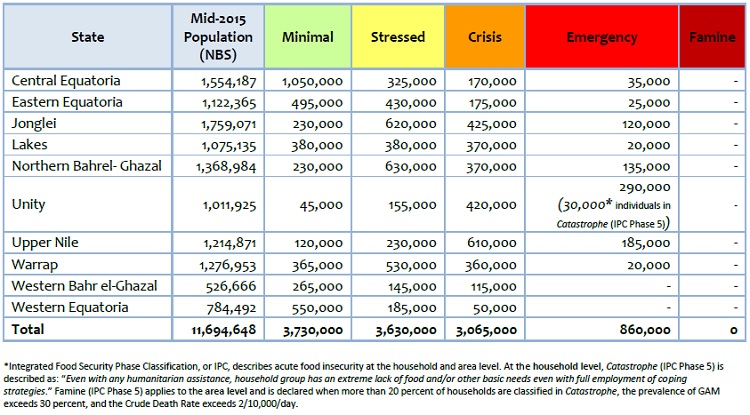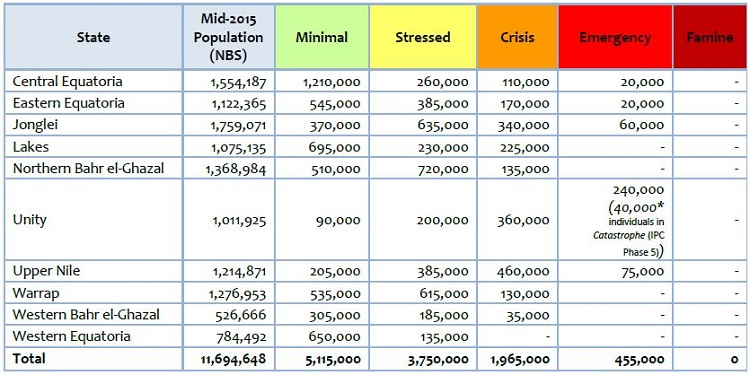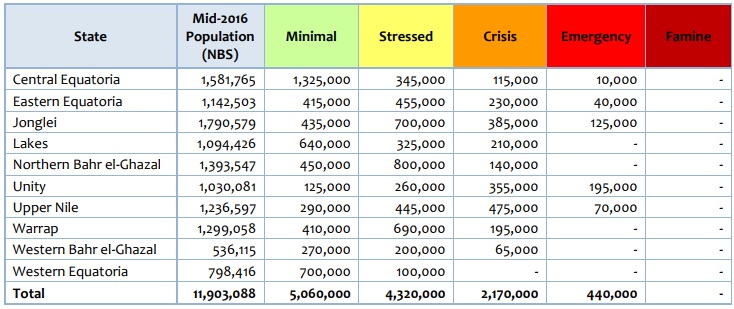01.09.2015
01.09.2015 > 31.12.2015
Map
Projected Map
Other Projections
Key
results
Population
estimates
Recommendations
& next steps
Acute
Malnutrition
An estimated 3.9 million people (3.1 million in Crisis and 800,000 in Emergency) or 34% of the population are classified as severely food and nutrition insecure and are unable to meet their food needs in September. This is an 80% increase compared to the same period last year. Of extreme concern are the estimated 30,000 people in Unity State who are experiencing Catastrophe and are likely to deteriorate into famine in the absence of urgent and immediate humanitarian access.
Although the August-September period typically marks the start of green harvests and reflects an improving situation from the peak-lean season, the long-term effects of the conflict coupled with high food prices, erratic rainfall patterns, depleted livelihood options and limited humanitarian access continue to put pressure on households’ food security affecting not only the Greater Upper Nile States, but also extending to traditionally stable states like Northern Bahr el-Ghazal, Lakes, Warrap and the Greater Equatoria States.
For the first time in the IPC history of South Sudan large deterioration can be seen in the Greater Equatoria region due to a combination of factors: market disruption, economic downturn, insecurity and localized crop failures.
The economic downturn has resulted in record high food prices (up to 150% compared to average) which has significantly affected the purchasing power of households across the country with significant effects being felt in Greater Bahr el-Ghazal States and the Urban-Poor population (30% in IPC Phase 3 and 4).
Conflict continues to have a profound impact on livelihoods. In Unity and Upper Nile States conflict continues to be a major driver of food insecurity through population displacements.
As the harvest season progresses (October to December), the food security situation is expected to progressively improve as households will have greater access to own production and income from crop sales.
The overall nutrition situation in August-September remains Critical with GAM prevalence above the Emergency threshold (GAM >15%) in the conflict affected states of the Greater Upper Nile region (Jonglei, Unity and Upper Nile States) and the perennially high malnutrition prevalence in the states of Northern Bahr el-Ghazal and Warrap.
Country Related Information
Contacts
- 01.04.2025 > 31.07.2025
South Sudan: Acute Malnutrition Situation Projection Update for April - June 2025 - 01.04.2025 > 31.07.2025
South Sudan: Acute Food Insecurity Situation Projection Update for April - July 2025 - 01.07.2024 > 30.06.2025
South Sudan: Acute Malnutrition Situation for July - September 2024 and Projections for October 2024 - March 2025 and April- June 2025 - 01.07.2024 > 30.06.2025
South Sudan: Acute Food Insecurity Situation for September - November 2024 and Projections for December 2024 - March 2025 and for April - July 2025 - 01.07.2023 > 30.06.2024
South Sudan: Acute Malnutrition Situation for July - September 2023 and Projections for October 2023 - March 2024 and April- June 2024 - 01.09.2023 > 31.07.2024
South Sudan: Acute Food Insecurity Situation for September - November 2023 and Projections for December 2023 - March 2024 and for April - July 2024 - 01.07.2022 > 30.06.2023
South Sudan: Acute Malnutrition Situation July - October 2022 and Projections for November 2022 - February 2023 and March - June 2023 - 01.10.2022 > 31.07.2023
South Sudan: Acute Food Insecurity Situation October - November 2022 and Projections for December 2022 - March 2023 and April - July 2023 - 01.02.2022 > 31.07.2022
South Sudan: Acute Malnutrition Situation for February - March 2022 and Projections for April - July 2022 - 01.02.2022 > 31.07.2022
South Sudan: Acute Food Insecurity and Acute Malnutrition Situation for February - March 2022 and Projections for April - July 2022 - 01.10.2020 > 31.07.2021
South Sudan: Acute Food Insecurity Situation for October - November 2020 and Projections for December 2020 - March 2021 and April - July 2021 - 01.01.2020 > 31.07.2020
South Sudan: Acute Food Insecurity Situation January 2020 and Projections for February - April 2020 and May - July 2020 - 01.01.2020 > 31.08.2020
South Sudan: Acute Malnutrition Situation January - April 2020 and Projection for May - August 2020 - 01.08.2019 > 30.04.2020
South Sudan: Acute Food Insecurity Situation for August 2019 and Projection for September - December 2019 and January - April 2020 - 01.08.2019 > 31.12.2019
South Sudan: Acute Malnutrition Situation for August 2019 and Projection for September - December 2019 - 01.05.2019 > 31.07.2019
South Sudan: Acute Food Insecurity Projection Update for May - July 2019 - 01.01.2019 > 31.07.2019
South Sudan: Acute Food Insecurity Situation January 2019 and Projections for February - April 2019 and May - July 2019 - 01.01.2019 > 31.08.2019
South Sudan: Acute Malnutrition Situation January - April 2019 and Projection for May - July 2019 - 01.09.2018 > 31.12.2018
South Sudan: Acute Malnutrition Situation September 2018 and Projection for October - December 2018 - 01.09.2018 > 31.03.2019
South Sudan: Acute Food Insecurity Situation in September 2018 and Projections for October-December 2018 and January-March 2019 - 01.01.2018 > 31.07.2018
South Sudan: Acute Malnutrition Situation in January 2018 and Projections for February-April 2018 and May-July 2018 - 01.01.2018 > 31.07.2018
South Sudan: Acute Food Insecurity Situation in January 2018 and Projections for February-April 2018 and May-July 2018 - 01.09.2017 > 31.12.2017
South Sudan: Acute Malnutrition Situation September 2017 and Projection for October - December 2017 - 01.09.2017 > 31.03.2018
South Sudan: Acute Food Insecurity Situation September 2017 and Projection for October - December 2017 and January - March 2018 - 01.05.2017 > 31.07.2017
South Sudan: Acute Malnutrition Situation for May 2017 and Projection for June - July 2017 - 01.05.2017 > 31.07.2017
South Sudan: Acute Food Insecurity Situation for May 2017 and Projection for June - July 2017 - 01.01.2017 > 31.07.2017
South Sudan: Acute Food Insecurity Situation for January 2017 and Projections for February - April 2017 and May - July 2017 - 01.09.2016 > 31.07.2017
South Sudan: Acute Malnutrition Situation for September 2016 - January 2017 and Projections for February - April 2017 and May - July 2017 - 01.08.2016 > 31.12.2016
South Sudan: Acute Malnutrition Situation August 2016 and Projection for September - December 2016 - 01.08.2016 > 31.12.2016
South Sudan: Acute Food Insecurity Situation August - September 2016 and Projection for October - December 2016 - 01.04.2016 > 31.07.2016
South Sudan: Acute Food Insecurity Situation in April 2016 and Projection for May-July 2016 - 01.01.2016 > 31.07.2016
South Sudan: Acute Malnutrition Situation January - April 2016 and Projection for May-July 2016 - 30.04.2015 > 30.09.2015
South Sudan: Acute Food Insecurity Situation in April 2015 and Projections for May - July 2015 and August - September 2015 - 01.01.2015 > 31.03.2015
South Sudan: Update of Acute Food Security Situation Projection for January - March 2015 - 01.09.2014 > 31.03.2015
South Sudan: Acute Food Insecurity Situation September 2014 and Projections for October - December 2014 and January - March 2015 - 01.05.2014 > 30.08.2014
South Sudan: Acute Food Insecurity Situation in May 2014 and Projection for June - August 2014 - 01.01.2014 > 31.01.2014
South Sudan: Acute Food Insecurity Situation in January 2014 - 30.07.2013 > 30.10.2013
South Sudan: Acute Food Insecurity Situation July - August 2013 and Projection for July - October 2013 - 18.11.2012 > 18.03.2013
South Sudan: Acute Food Insecurity Situation in November 2012 and Projection for November 2012 - March 2013 - 25.08.2012 > 30.11.2012
South Sudan: Acute Food Insecurity Situation August 2012 and Projection for August - November 2012 - 01.04.2012 > 20.07.2012
South Sudan: Acute Food Insecurity Situation April 2012 and Projection for April-July 2012 - 09.12.2011 > 31.03.2012
South Sudan: Acute Food Insecurity Situation December 2011 and Projection for December 2011 - March 2012
- 22.04.2025 > 06.05.2025
South Sudan: Acute Food Insecurity and Acute Malnutrition Analyses (Update) - 25.09.2024 > 05.10.2024
South Sudan: Acute Food Insecurity and Acute Malnutrition Analyses - 18.09.2023 > 28.09.2023
South Sudan: Acute Food Insecurity and Acute Malnutrition Analyses - 03.10.2022 > 15.10.2022
South Sudan: Acute Food Insecurity and Malnutrition Analyses
Join our mailing list







